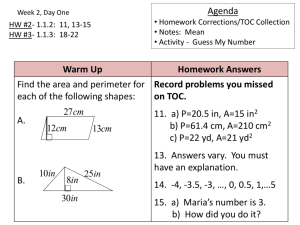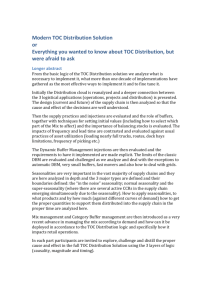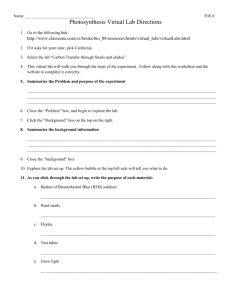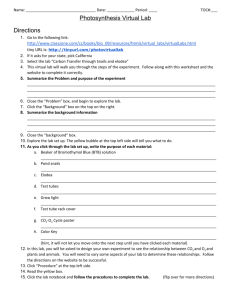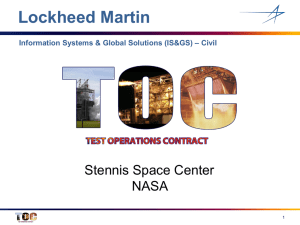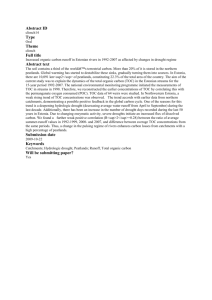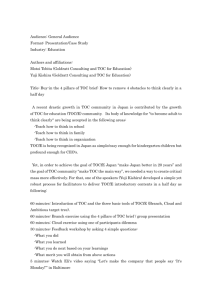IMPRSYS-Assignment 2
advertisement
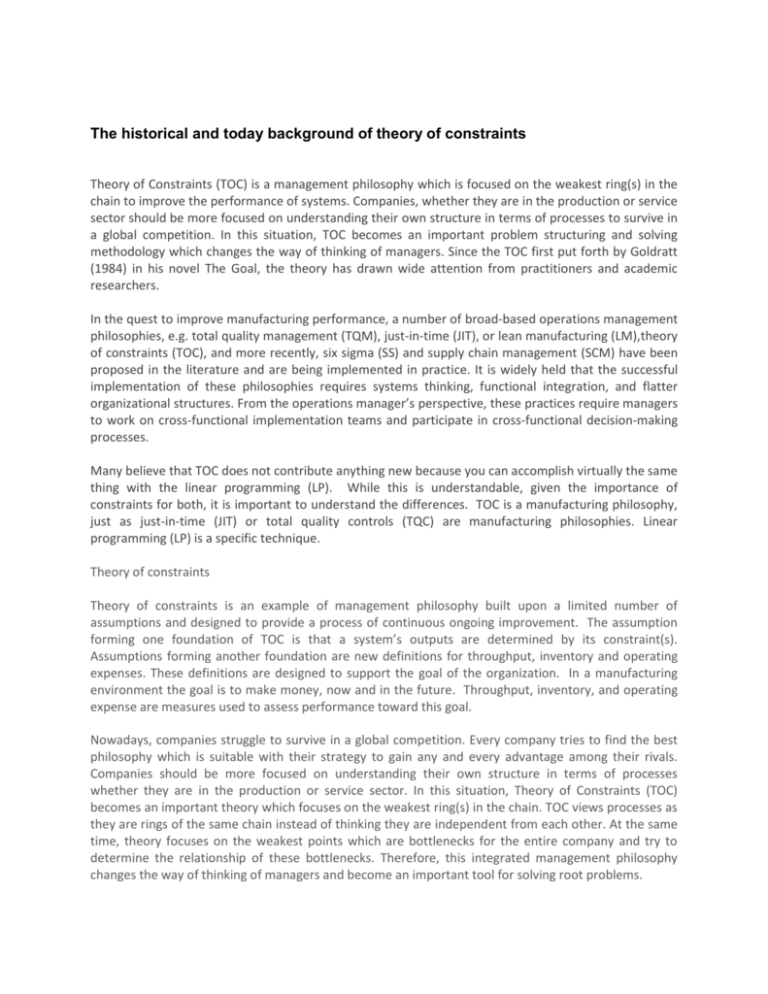
The historical and today background of theory of constraints Theory of Constraints (TOC) is a management philosophy which is focused on the weakest ring(s) in the chain to improve the performance of systems. Companies, whether they are in the production or service sector should be more focused on understanding their own structure in terms of processes to survive in a global competition. In this situation, TOC becomes an important problem structuring and solving methodology which changes the way of thinking of managers. Since the TOC first put forth by Goldratt (1984) in his novel The Goal, the theory has drawn wide attention from practitioners and academic researchers. In the quest to improve manufacturing performance, a number of broad-based operations management philosophies, e.g. total quality management (TQM), just-in-time (JIT), or lean manufacturing (LM),theory of constraints (TOC), and more recently, six sigma (SS) and supply chain management (SCM) have been proposed in the literature and are being implemented in practice. It is widely held that the successful implementation of these philosophies requires systems thinking, functional integration, and flatter organizational structures. From the operations manager’s perspective, these practices require managers to work on cross-functional implementation teams and participate in cross-functional decision-making processes. Many believe that TOC does not contribute anything new because you can accomplish virtually the same thing with the linear programming (LP). While this is understandable, given the importance of constraints for both, it is important to understand the differences. TOC is a manufacturing philosophy, just as just-in-time (JIT) or total quality controls (TQC) are manufacturing philosophies. Linear programming (LP) is a specific technique. Theory of constraints Theory of constraints is an example of management philosophy built upon a limited number of assumptions and designed to provide a process of continuous ongoing improvement. The assumption forming one foundation of TOC is that a system’s outputs are determined by its constraint(s). Assumptions forming another foundation are new definitions for throughput, inventory and operating expenses. These definitions are designed to support the goal of the organization. In a manufacturing environment the goal is to make money, now and in the future. Throughput, inventory, and operating expense are measures used to assess performance toward this goal. Nowadays, companies struggle to survive in a global competition. Every company tries to find the best philosophy which is suitable with their strategy to gain any and every advantage among their rivals. Companies should be more focused on understanding their own structure in terms of processes whether they are in the production or service sector. In this situation, Theory of Constraints (TOC) becomes an important theory which focuses on the weakest ring(s) in the chain. TOC views processes as they are rings of the same chain instead of thinking they are independent from each other. At the same time, theory focuses on the weakest points which are bottlenecks for the entire company and try to determine the relationship of these bottlenecks. Therefore, this integrated management philosophy changes the way of thinking of managers and become an important tool for solving root problems. Originally TOC is used to plan the production process and allocate resources but its content is improved day by day as the technology evolves and competition between rival companies increases in business world. Nowadays it can be used a kind of management philosophy and can be integrated with cost accounting system. It is not of importance which sector your company belongs because TOC is actually based on system improvement. Since 30 years, TOC is successfully implemented by almost every sector and with almost every size of companies. TOC is based on the idea that every system has at least one bottleneck which can be defined as any kind of situation that impedes the system to reach high performance level in terms of its purposes (Goldratt, 1990). In literature there are several studies to understand this management philosophy in detail. In their study Watson et. al. (2007) stated that to better understand the historical evaluation of TOC it can be useful to separate its evaluation into five eras; (i)The optimized product technology era, (ii)The goal era, (iii)The haystack syndrome era, (iv) The it’s not luck era and (v)The critical chain era (Watson et.al., 2007). This classification is useful to see how this philosophy evolves through time and how the main point of TOC researches evolves. In literature initial studies generally focused on optimized production technology which is improved by Goldratt in 1980s. On the other hand when the book named “The Goal” published in 1984, studies about TOC were rapidly increased and researchers started focus on the architecture of drum-buffer-rope. After the importance of TOC is realized by academicians and managers, studies started to focus on TOC measures, thinking processes which is one of the most important tool of TOC and project management and etc. Recently, after almost 30 years TOC is still one of the greatest strategies for companies. Bibliography Aggarwal1985 S.C Aggarwal: Harvard Business Review, 63(5) (1985), pp8-16. Alex Coman, et al. Production outsourcing: A linear programming model for the Theory-OfConstraints Volume 38, Issue 7, 2000 Chase Jacobs, Operational and Supply Chain Management 13th Edition, pp International Journal of Operations & Production Management Vol. 28 No. 10, 2008, pp. 9911012. International Journal Production Research Vol. 30, No.6, 1992, pp1471-1478. Jaydeep Balakrishnan, et al. Discussion: Theory of constraints and linear programming: A reexamination Volume 38, Issue 6, 2000 John H. Blackstone Theory of constraints - A status report Volume 39, Issue 6, 2001 L. D. Fredendall, et al. Improving the product mix heuristic in the theory of constraints Volume 35, Issue 6, 1997 M. S. SPENCER, et al. Optimum production technology (OPT) and the theory of constraints (TOC): analysis and genealogy Volume 33, Issue 6, 1995 Shafer, S. Mand J. R. Meredith. 1998. Operations Management: A Process Approach with Spreadsheets. New York: John Wiley & Sons. 1. Introduction To do so, managers need a common language, the language of theory (Handfield and Melnyk, 1998). Areas such as marketing, finance, strategy, and organizational behavior are well grounded in theory-development methods but the need for theory-building, testing, and modification in operations management (OM) has been widely recognized (Meredith et al. , 1989; Flynn et al. , 1990; Swamidass, 1991; McCutcheon and Meredith, 1993). Westbrook (1995) suggested that OM academics must embrace creative tension between theory and practice and must develop new theories from the observation of actual practices. Theory development remains the most fertile research area in the field of operations management (Westbrook, 1995; Pannirselvam et al. , 1999). A number of attempts have been made to develop and propose theories and theory-like principles of The current issue and full text archive of this journal is available at www.emeraldinsight.com/0144-3577.htm Theory of constraints 991 Received October 2006 Revised December 2006, December 2007, May 2008 Accepted May 2008 International Journal of Operations & Production Management Vol. 28 No. 10, 2008 pp. 991-1012 q Emerald Group Publishing Limited 0144-3577 DOI 10.1108/01443570810903122 operations management. These attempts include: trade-off theory (Skinner, 1969), the process-product matrix (Hayes and Wheelwright, 1979), the customer-contact model (Chase and Tansik, 1983), the TOC (Goldratt and Cox, 1984; Boyd and Gupta, 2004), the cumulative theory (Ferdows and DeMeyer, 1990), the theory of production competence (Cleveland et al. , 1989; Vickery, 1991), priority management theory (Westbrook, 1994), the theory of TQM (Flynn et al. , 1994; Handfield and Melnyk, 1998), the theory of swift and even flow, and the theory of performance frontiers (Schmenner and Swink, 1998). This list is not exhaustive but rather an attempt to highlight major initiatives undertaken in the academic OM literature. Schmenner and Swink (1998) further suggested that these theories in operations management should be carefully examined, refined and, if warranted, abandoned. In this paper, we examine the TOC as a unifying theory in operations management. A significant number of journal articles have been written: . to trace the history of optimized production technology, the predecessor to TOC (Goldratt, 1988; Fry et al. , 1992) as well as that of TOC (Gardiner and Blackstone, 1994, Watson et al. , 2007); . to review the basic concepts of TOC (Ronen and Starr, 1990; Fawcett and Pearson, 1991); . to categorize TOC concepts and terms (Spencer and Cox, 1995); . to review TOC literature (Rahman, 1998; Balderstone and Mabin, 1998) and successful applications (Mabin and Balderstone, 2003, Kim et al. , 2008); . to demonstrate applications of TOC in various areas such as SCM, enterprise resource planning, sales and marketing, human resource management (Blackstone, 2001), and strategic planning (Gupta et al. , 2004) . to highlight its current applications (Gupta, 2003); and . to place it among extant operations research/management science methodologies (Davies et al. , 2005). SUMMARY Since initial work done by Goldratt in the mid-1980s and as the concepts related to the theory of constraints (TOC) have become more developed, many have concluded that the TOC approach offers nothing in addition to what can be accomplished through linear programming (LP). Through the use of an example, this paper compares TOC to LP and clarifies the differences surrounding the TOC philosophy and the LP technique Skip to content Taylor & Francis Online recently reset password strength requirements. If your login is unsuccessful, please use the 'Forgot password' link to reset your password. Customers with access by IP recognition, remote password, OpenAthens or Shibboleth are not affected. Librarians Authors & Editors Societies Register Sign in Mobile Access provided by Chevron Texaco Corporation Browse Products Open access Shortlist Cart The online platform for Taylor & Francis Group content Search Search Advanced and citation search Within current journal Entire site Home > List of Issues > Table of Contents > Theory of constraints and linear programming: a comparison Browse journal View all volumes and issues Current issue Latest articles Most read articles Most cited articles Open access articles Submit Call for papers Instructions for authors Submit online Subscribe About this journal Aims & scope Journal information Editorial board Abstracting & indexing Readership Society information News & offers International Journal of Production Select Language ▼ Research Translator disclaimer Volume 30, Issue 6, 1992 Theory of constraints programming: a comparison Sorry, you do not have access to this article. and linear How to gain access: Recommend to your librarian that your institution purchase access to this publication. Log in If you already have an individual subscription, please log in using your Taylor & Francis Online ID to gain access. /doi/pdf/10.1080/0 /doi/pdf/10.1080/0 Log in details Email Address password Remember Me Forgot password Register Shibboleth OpenAthens Purchase Purchase options Sign in Price * Article Purchase USD 48.00 Add to cart *Local tax will be added as applicable DOI: 10.1080/00207549208942967 RICHARD LUEBBEa & BYRON FINCHa pages 1471-1478 Publishing models and article dates explained Received: 1 Aug 1991 Published online: 08 Jul 2010 PreviewDownload full text Access Options Alert me Password Forgot New content email alert New content RSS feed Citation email alert Citation RSS feed SUMMARY Since initial work done by Goldratt in the mid-1980s and as the concepts related to the theory of constraints (TOC) have become more developed, many have concluded that the TOC approach offers nothing in addition to what can be accomplished through linear programming (LP). Through the use of an example, this paper compares TOC to LP and clarifies the differences surrounding the TOC philosophy and the LP technique Download full text Related articles View all related articles Share on facebookShare on twitterShare on emailMore Sharing Services Add to shortlist Link Permalink http://dx.doi.org/10.1080/00207549208942967 Download Citation Recommend to: A friend First page preview Close Download full text Click to increase image sizeClick to decrease image size Information References Citations Reprints & permissions Details Citation information: Web of Science ® Received: 1 Aug 1991 Published online: 08 Jul 2010 Author affiliations a Department of Management, Richard J. Farmer School of Business Administration , Miami University , Oxford, OH, 45056, USA Journal news 2014 Impact Factor: 1.477 ©2015 Thomson Reuters, 2015 Journal Citation Reports® Call for Papers: Warehouse Design and Management Article metrics Views: 89 Citations CrossRef Web of Science (68) Article metrics information Users also read o Theory of constraints - A status report John H. Blackstone (52) Volume 39, Issue 6, 2001 o Discussion: Theory of constraints and linear programming: A re-examination Jaydeep Balakrishnan, et al. Volume 38, Issue 6, 2000 o Improving the product mix heuristic in the theory of constraints L. D. Fredendall, et al. Volume 35, Issue 6, 1997 o Optimum production technology (OPT) and the theory of constraints (TOC): analysis and genealogy M. S. SPENCER, et al. Volume 33, Issue 6, 1995 o Production outsourcing: A linear programming model for the Theory-OfConstraints Alex Coman, et al. Volume 38, Issue 7, 2000 Librarians Librarians' area Pricing Institutional account Access entitlements Co-branding IP ranges Link resolver preferences Usage reports Authors & Editors Book authors Journal authors Reference work authors Editors Societies Current partners Publish with us Help & Information Help FAQs Contact us Press releases Taylor & Francis Group Privacy Policy & Cookies Terms & Conditions Accessibility Powered by Atypon® Literatum © Informa UK Limited, an Informa Group Company

